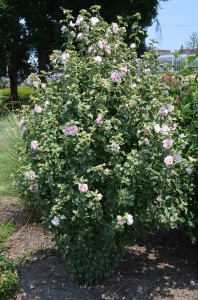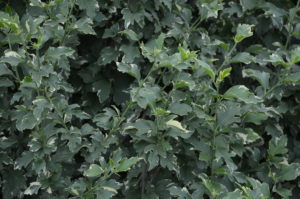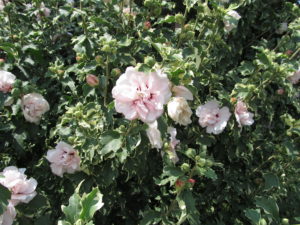Rose of Sharon or shrub althea (Hibiscus syriacus) is a vigorous, upright, multi-branched, deciduous shrub that generally grows 8-12 feet tall and 4-6 feet wide. Althea is native from eastern to central Asia (USDA hardiness zones 5-8).
Sugar Tip® is a patented variety that features variegated creamy-white and blue-green foliage and soft pink double flowers. Leaf variegation is its unique trait. It produces smallish pale-colored double flowers that do not garner as much notice as the large single flowered varieties.
The 5-petaled double flowers, up to 3 inches across, appear over a long, early-summer to fall bloom period. The pink double flowers have prominent floral stamens in center. Flowers are mostly sterile, resulting in no weedy seedlings to pop up around your property.
Altheas tend to leaf out in late spring. The 3-4 inch long, 3-lobed, medium green leaves are palmately-veined. The blemish-free variegated foliage remains attractive from late spring through mid-autumn. Fall foliage color is inconsequential.
Altheas are easily grown in average, moist, well-drained, moderately acidic soils and in full to partial sun. Under partial shade altheas bloom less and can become weak wooded, and more prone to disease issues. Best flowering occurs in full sun. This shrub is highly summer heat and humidity tolerant. Altheas are frequently seen planted in downtown urban congested areas.
Altheas bloom on new wood, so pruning is performed in late winter or spring. Heavy pruning results in less blooms which are much larger in size. Altheas are easily propagated by softwood stem cuttings collected in late spring. Sugar Tip may be trained as a small tree or espaliered.
No serious insect or disease problems trouble this tough hardy shrub. Occasionally, leaf spots, blights, rusts and cankers may appear if site location is poor. Japanese beetles, whiteflies and aphids are occasional insect feeders. In some years Japanese beetles may severely damage foliage when left unchecked.
As with most shrub altheas, they serve as superior summer flowering shrubs. Plant single specimen shrub or tree; mass several together as foundation or border shrubs, or as a deciduous privacy hedge or screen.




 Posted in
Posted in 
